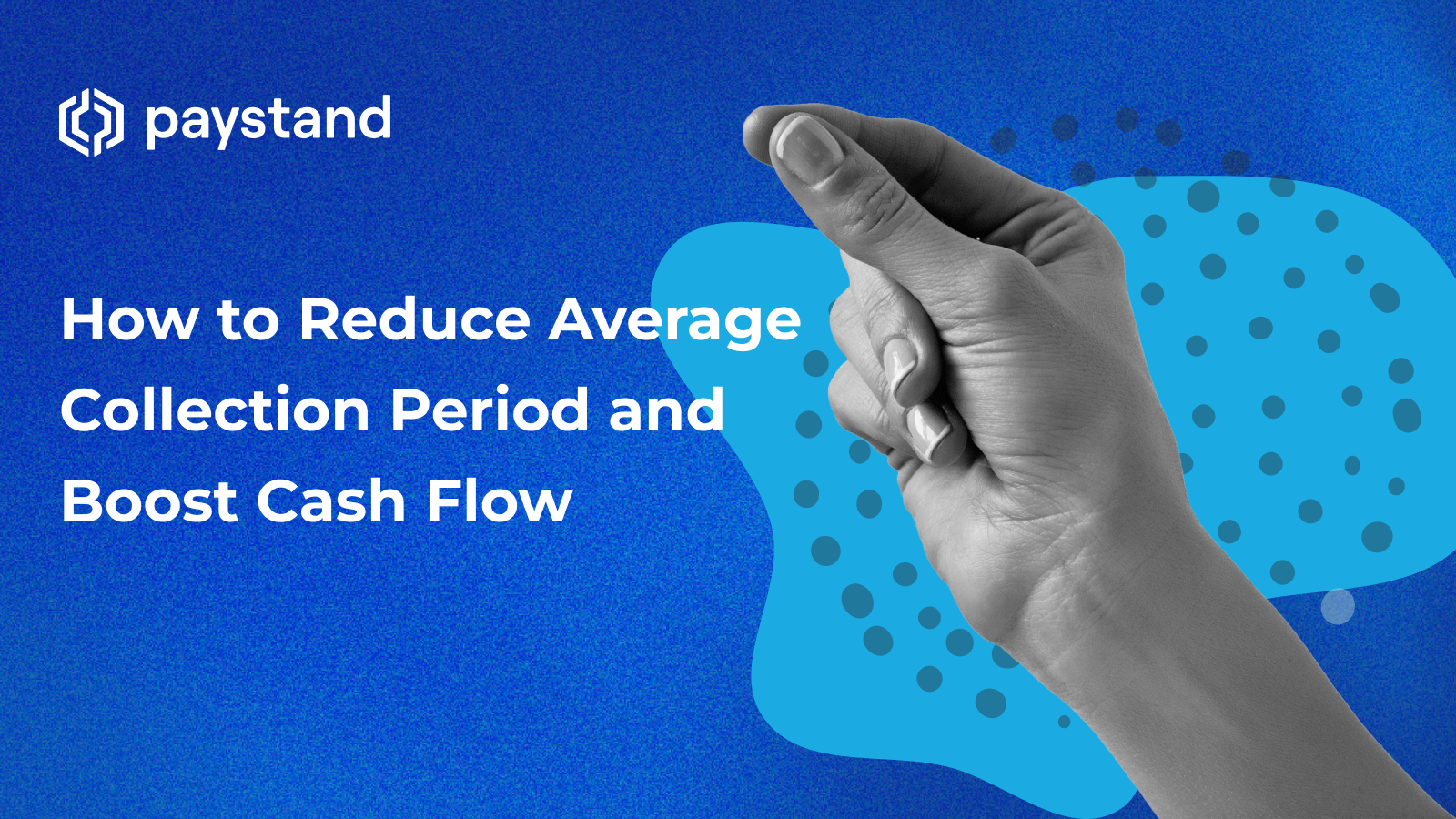How to Reduce Average Collection Period and Boost Cash Flow

Table of Contents
- What is the average collection period?
- What is a good average collection period?
- Strategies for reducing the average collection period
- How Paystand addresses collection challenges
Key Takeaways
- Effective accounts receivable management influences cash flow, operational efficiency, and growth potential, fostering financial stability and stakeholder trust.
- The average collection period (ACP) measures the average time it takes to collect customer payments after a sale.
- A shorter ACP improves cash flow and financial flexibility, while a prolonged ACP may indicate inefficiencies or financial challenges.
- Strategies to optimize ACP include leveraging automation, offering clear payment terms, early payment incentives, diverse payment options, and conducting regular accounts receivable reviews.
- Reducing ACP supports financial stability, builds stakeholder trust, and positions businesses for innovation and growth.
The health of your business hinges on how effectively you manage key financial metrics. One such cornerstone is accounts receivable management, which directly impacts cash flow, operational efficiency, and growth potential. The average collection period—representing the time it takes to collect customer payments—offers a powerful lens to assess these dynamics. By optimizing this metric, businesses can unlock financial stability and seize opportunities for innovation and expansion.
But how do you calculate, analyze, and improve your average collection period? More importantly, what strategies and tools can you implement to ensure their alignment with your broader business financial management goals? Dive into this guide to discover actionable insights that empower financial controllers like you to make data-driven decisions and elevate your organization’s financial performance.
What is the Average Collection Period?
The average collection period is a critical metric that measures the average number of days it takes to collect customer payments after a sale. It reflects a company’s cash flow efficiency, operational performance, and ability to seize growth opportunities.
A short ACP ensures faster access to cash, enabling reinvestment in innovation, scaling operations, and fostering stronger customer relationships. Conversely, a prolonged ACP may signal inefficiencies or financial strain. Monitoring and optimizing this metric is essential for maintaining financial health in a competitive market.
How to Calculate the Average Collection Period
To harness the benefits of this metric, it’s essential to understand how to calculate the average collection period. The AR collection period formula is straightforward and widely used across industries:
ACPeriod = Accounts Receivable × 365
Net Credit Sales
This average collection period equation reveals the average days it takes to convert receivables into cash. For example, if your business has $100,000 in accounts receivable and $1,000,000 in annual net credit sales, your average collection period is:
100,000 × 365 = 36.5 days
1,000,000
This formula provides actionable insights into how efficiently receivables convert to cash. By tracking this metric regularly, you can identify trends, address payment delays, and improve financial processes.
💡Why It Matters
Understanding ACP goes beyond tracking receivables. If your ACP exceeds payment terms, it may highlight operational inefficiencies or customer payment delays. Addressing these issues helps optimize working capital, strengthen stakeholder trust, and ensure steady cash flow.
What is a Good Average Collection Period?
A “good” ACP aligns with your payment terms. For instance, if you offer 30-day terms, an ACP of 30–35 days is acceptable. Businesses with shorter ACPs typically experience greater financial flexibility, while longer periods can lead to cash flow challenges.
Factors influencing an ideal ACP include:
- Industry standards: Retail businesses often aim for shorter periods, while B2B companies may handle longer payment cycles.
- Payment terms: Extended terms naturally cause longer ACPs.
- Customer base: A diverse customer base can lead to variability in payment behaviors.
A good ACP balances efficiency with your business's and stakeholders' needs.
Strategies for Reducing the Average Collection Period
Reducing ACP is critical for improving cash flow and operational efficiency. Here’s how you can achieve this:
☑️Automate Invoicing and Payment Processes
Implement tools to automate invoicing, payment reminders, and receivables tracking. Automation minimizes manual errors, accelerates collection processes, and integrates seamlessly into your workflows.
☑️Offer Clear Payment Terms
Ensure contracts and invoices clearly outline payment terms, due dates, and penalties for late payments. Communicating terms upfront sets expectations and promotes accountability.
☑️Provide Discounts for Early Payments
Offer discounts for early payments to motivate customers. For example, a 2% discount on payments made within 10 days can expedite cash flow while fostering goodwill.
☑️Diversify Payment Methods
To make it easy for customers to pay, offer options such as credit cards, ACH transfers, and digital wallets. Simplifying payment processes reduces friction and encourages faster transactions.
☑️Regularly Review Accounts Receivable
Conduct routine reviews to identify overdue payments, spot patterns, and proactively address challenges. Leveraging tools like an ACP calculator can streamline this process.
☑️Collaborate with Innovative Financial Solutions
Partner with technology-driven platforms like Paystand to revolutionize receivables management. Embrace features such as blockchain networks, real-time payments, and zero-fee transactions to reduce ACP and enable long-term growth.
How Paystand Addresses Collection Challenges
The average collection period is more than a number; it reflects your business’s financial health and operational efficiency. Understanding how to calculate it and implementing strategies to reduce it can unlock significant benefits, from improved cash flow to greater profitability.
Paystand is redefining how businesses manage their accounts receivable, offering solutions that directly target the challenges of reducing the average collection period. Here’s how your business benefits from Paystand’s innovative approach:
- Real-time payment network
- Automated reminders
- Multiple payment methods
- Blockchain technology
- Zero-fee transactions
By reducing the average collection period, your business contributes to a more resilient and dynamic financial system. With Paystand, you’re not just optimizing your processes—you’re part of a movement toward a fairer, more efficient economy.
Ready to transform your financial operations? Partner with Paystand to revolutionize your receivables process and join the movement toward a smarter, fairer financial system. Book a demo today to see how Paystand can help you achieve unparalleled efficiency and financial growth.





.jpg?width=1634&height=1980&name=INFOGRAPHIC---Collection-period%20(2).jpg)
